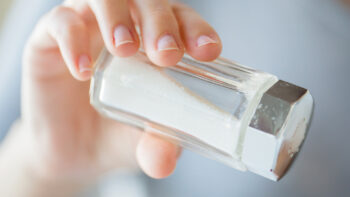
A lot of people love adding salt to their food because it makes it taste better. However, many complications can affect you if you are taking in too much salt in your body. Nutritionists recommend no more than approximately 2,300 mg of sodium per day. However, since sodium is present in almost everything we consume, it is not always easy to follow this standard.
Sodium is present in almost all the food that can be bought in the grocery store. This includes obviously salty foods like junk foods, but it also includes foods that do not taste salty but have high sodium content, like cottage cheese. Even a slice of bread, which you would not typically consider a source of sodium, can contain up to 230 mg of sodium.
If you do not measure sodium in your diet, you might exceed the daily recommended amount, resulting in poor health and over time, potentially leading to stroke, heart failure and other serious problems.
Understanding the Sodium Limit
One of the biggest myths in the health world is that you should not worry about your sodium intake if you are young. However, there’s a lot of research showing that sodium can affect your organs if you exceed the daily sodium limit recommended by experts.
Sodium Limits Depending on Age
There is still some disagreement about how much sodium you should intake daily. The World Health Organization (WHO) recommends up to 2,000 mg of sodium per day, but the American Heart Association suggests a lower sodium limit at only 1,500 mg a day.
As a general guideline, however, this is the maximum daily recommended sodium intake depending on age:
- 1-3 years old: 1,000 mg per day
- 4-8 years old: 1,200 mg per day
- 9-50 years old: 1,500 mg per day
- 51-70 years old: 1,300 mg per day
- Over 70 years old: 1,200 mg per day
People With High Blood Pressure
The sodium limit above is recommended for people who are living healthy. However, if you have high blood pressure or are at risk of having high blood pressure, you should further lower your sodium intake. While the exact amount of sodium intake is still debatable, experts are sure that sodium increases blood pressure.
It is estimated that an average American consumes around 3,400 mg of sodium per day. Some can even intake up to 7,000 mg of sodium in just a single day. If you have high blood pressure, you need to lower this amount by limiting the sodium in your food.
Restricting your sodium intake can not only lower your blood pressure, but it can also improve your body’s response to blood pressure medication.
Buying Low Sodium Foods
Almost every food in the grocery store has nutritional information on its packaging. You can check this label and compare different food brands to find out which has the lowest sodium level. It would be best to opt for a grocery basket full of lower sodium foods to help you with your diet.
If you need to buy frozen or canned fruits or vegetables, you can choose brands with low sodium levels or, better yet, ones with no salt added.
Using Alternative Spices
People add sodium to food because it makes it tastier. However, many other spices have low sodium and can still make your food taste good. You can also Google recipes with low sodium so that you can have a low sodium diet without sacrificing delicious foods at all.
While it is difficult at first, it actually only takes 6-8 weeks to get used to having a lower sodium level in your food. Since salt preference is an acquired taste, you can train yourself to remove this preference and help you to have a lower sodium diet.
Exercising to Get Rid of Sodium
When you exercise, you lose sodium in the form of sweat. Research shows that a manual laborer working an 8-hour shift can lose 5,000 mg of sodium in just a single day.
While working out for eight hours a day is impossible for other people, you can still lower your body’s sodium levels by performing at least 30 minutes of intense exercise each day. Just be sure to follow your sodium limit if you are not as active as a manual laborer.
Eating a Low-Sodium Diet
Stick to Fruits and Vegetables
It is not surprising to hear that almost all processed food has a certain amount of sodium. So, if you want to limit your sodium intake, you can plan your meals with only fruits and vegetables. There are almost no sodium-free foods aside from fresh fruits and vegetables, and if you are on a low sodium diet, these are the foods that are great for you.
Even canned and frozen fruits have lower sodium levels compared to other foods. However, it is still safer to go for fresh fruits and vegetables since they have the least sodium.
Potassium and Magnesium
If you are worried about your blood pressure, you can stick to foods with high potassium and magnesium levels that can effectively lower your blood pressure. Partnered with other low sodium foods, having a diet rich with potassium and magnesium can help you avoid the complications of having a high level of sodium in your body, such as stroke and high blood pressure.
Fresh Meat Instead of Processed
If you cannot totally avoid meat, you should try to stick with fresh cut meat instead of processed. While meat still has natural sodium, it is much lower than processed meats like bacon and ham that have added sodium during the processing.
Ask Restaurants to Avoid Salt
If you are dining out, you can inform your server that you are trying to lessen your sodium intake or that you are on a low sodium diet so that they can avoid adding salt to your meal. You can also reduce the portion of your food size when eating out so that you do not intake more sodium for that day.
Alternatively, you can also check their nutritional information online if it is available. You can then plan your other meals ahead of time so that you do not have to worry about exceeding your sodium intake for that day.
By Admin –



